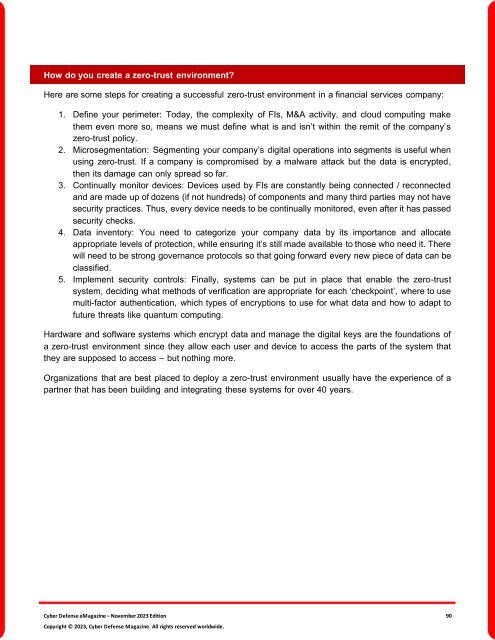The Cyber Defense eMagazine November Edition for 2023
Cyber Defense eMagazine November Edition for 2023 #CDM #CYBERDEFENSEMAG @CyberDefenseMag by @Miliefsky a world-renowned cyber security expert and the Publisher of Cyber Defense Magazine as part of the Cyber Defense Media Group as well as Yan Ross, Editor-in-Chief and many more writers, partners and supporters who make this an awesome publication! 196 page November Edition fully packed with some of our best content. Thank you all and to our readers! OSINT ROCKS! #CDM #CDMG #OSINT #CYBERSECURITY #INFOSEC #BEST #PRACTICES #TIPS #TECHNIQUES
Cyber Defense eMagazine November Edition for 2023 #CDM #CYBERDEFENSEMAG @CyberDefenseMag by @Miliefsky a world-renowned cyber security expert and the Publisher of Cyber Defense Magazine as part of the Cyber Defense Media Group as well as Yan Ross, Editor-in-Chief and many more writers, partners and supporters who make this an awesome publication! 196 page November Edition fully packed with some of our best content. Thank you all and to our readers! OSINT ROCKS! #CDM #CDMG #OSINT #CYBERSECURITY #INFOSEC #BEST #PRACTICES #TIPS #TECHNIQUES
You also want an ePaper? Increase the reach of your titles
YUMPU automatically turns print PDFs into web optimized ePapers that Google loves.
How do you create a zero-trust environment?<br />
Here are some steps <strong>for</strong> creating a successful zero-trust environment in a financial services company:<br />
1. Define your perimeter: Today, the complexity of FIs, M&A activity, and cloud computing make<br />
them even more so, means we must define what is and isn’t within the remit of the company’s<br />
zero-trust policy.<br />
2. Microsegmentation: Segmenting your company’s digital operations into segments is useful when<br />
using zero-trust. If a company is compromised by a malware attack but the data is encrypted,<br />
then its damage can only spread so far.<br />
3. Continually monitor devices: Devices used by FIs are constantly being connected / reconnected<br />
and are made up of dozens (if not hundreds) of components and many third parties may not have<br />
security practices. Thus, every device needs to be continually monitored, even after it has passed<br />
security checks.<br />
4. Data inventory: You need to categorize your company data by its importance and allocate<br />
appropriate levels of protection, while ensuring it’s still made available to those who need it. <strong>The</strong>re<br />
will need to be strong governance protocols so that going <strong>for</strong>ward every new piece of data can be<br />
classified.<br />
5. Implement security controls: Finally, systems can be put in place that enable the zero-trust<br />
system, deciding what methods of verification are appropriate <strong>for</strong> each ‘checkpoint’, where to use<br />
multi-factor authentication, which types of encryptions to use <strong>for</strong> what data and how to adapt to<br />
future threats like quantum computing.<br />
Hardware and software systems which encrypt data and manage the digital keys are the foundations of<br />
a zero-trust environment since they allow each user and device to access the parts of the system that<br />
they are supposed to access – but nothing more.<br />
Organizations that are best placed to deploy a zero-trust environment usually have the experience of a<br />
partner that has been building and integrating these systems <strong>for</strong> over 40 years.<br />
<strong>Cyber</strong> <strong>Defense</strong> <strong>eMagazine</strong> – <strong>November</strong> <strong>2023</strong> <strong>Edition</strong> 90<br />
Copyright © <strong>2023</strong>, <strong>Cyber</strong> <strong>Defense</strong> Magazine. All rights reserved worldwide.

















